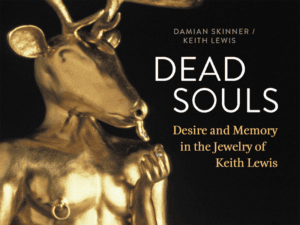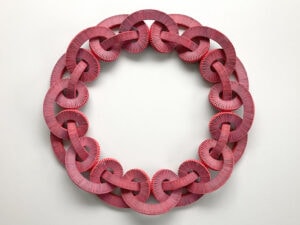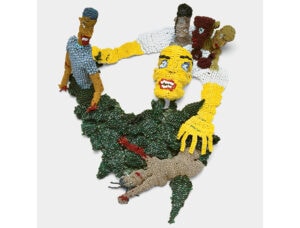The Rings of Saturn
June 6–October 19, 2014
Manchester Art Gallery, Manchester, England
Take any length of string, wire, or chain, link it together at one end, and you have a necklace. This simple construction can then be embellished with, theoretically, anything, as long as it can be attached in some way to the necklace loop. Across the centuries and throughout the world, beads, colored stones, work passes, shells, keys, precious stones, souvenirs of some kind or another, have all found their homes around our necklines. Sometimes there is a succession of similar material—a series of identical wooden beads, for example—and sometimes a necklace is like a subway’s path, with each stop around your neck providing something of interest that demands further exploration. Seldom are saw blades, scissors, broken bottlenecks, and jagged pieces of glass part of this confection, except, as palpably demonstrated in The Rings of Saturn at the Manchester Art Gallery, in the work of Bernhard Schobinger.

The Swiss artist’s survey exhibition, curated by Jo Bloxham and supported by Gallery S O, presents a selection of work from the last 40 years (Gallery S O procured Schobinger’s work, assisted with the selection, and contributed to the installation setup). Presented in one room adjacent to the shop, the majority of the work is encased in echte-Victorian vitrines—the real thing. Six identical plaster-cast busts—imperfect and jagged like the necklaces they display—line one wall, with one large vitrine in the center of the gallery housing Sea Shells Ballet (2013), a whimsical supersized chain of shells with daubs of paint on them. The two vitrines on either side of this centerpiece would not look amiss in any natural history museum. They consist of a thigh-level case that contains many of Schobinger’s necklaces and pendants, and an eye-level narrow glass one for the rings. Both have horizontal surfaces covered with neutral gray muslin to which the jewelry is pinned.
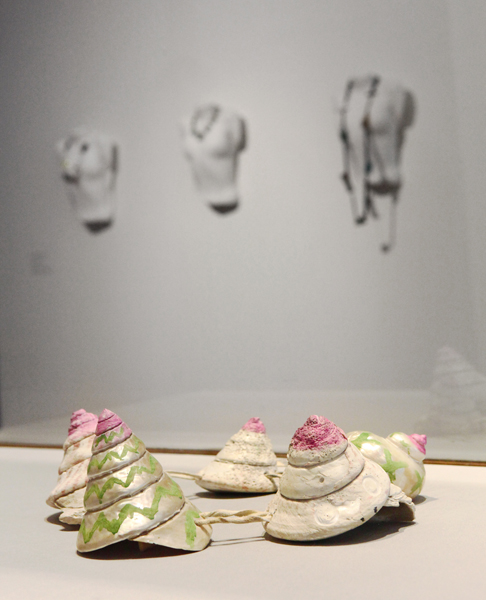
In the context of such readymade categorization, we can think of Schobinger’s readymades as very assisted. The readymade things he uses are not just tied to rings and necklaces in a casual or haphazard manner as a callous cavalier statement. Like many other contemporary jewelers, Schobinger uses readymades in a way that demonstrates his skill as a highly trained maker. However, unlike some of the more “in your face” uses of everyday objects and refusals to follow the conventions of jewelry—the work of Lisa Walker, Karl Fritsch, and Mia Maljojoki comes to mind—Schobinger’s pieces draw you into the detail, in particular the chains, hoops, and holes that connect the readymade objects. Given Schobinger’s claim that “like the links of a chain, everything in the universe seems in an unfathomable way to be interconnected,” this attention to the materiality of the in-between comes as no surprise.
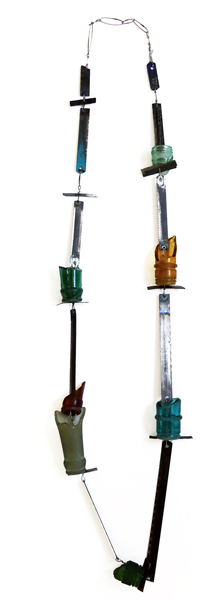
The connections also require holes for the linking chains to loop through. Thus Schobinger bores through the readymades he uses—including the lenses of sunglasses, where radiating reverberations of the drill used to cut through the plastic can be seen as small concentric circles around the hole. The incision is well thought-through and polite: Schobinger seems more respectful of the holes than of century-long traditions of jewelry practice. As he writes in the book that accompanies the show, “the usefulness of a ring rests on the nothingness about it (the hole).” This wholly hole-y attention is evident in the way certain necklaces harness the holes that already exist within the readymades Schobinger uses. In Okinawa Bottleneck Chain (2013), he threads a necklace wire through the openings of broken bottle necks and links it through the small holes found on either end of a hacksaw blade (the holes that allow one to tighten or loosen the tension on the blade via a wing nut at one end).
The hacksaw blade is one tool on show. Another type is the embroidery scissors used by his mother, aunt, and grandmother, used on the necklace that graces the front cover of Crafts magazine’s issue 249 (July/August 2014). Both suggest violence. The scissors look like they could have been plunged in blood, but instead of blood droplets we have pearls that make the scissors look like they are weeping, not bleeding. The hacksaw blades are also curled into rings (pierced by a screw in one instance) upon which Schobinger sets precious stones.
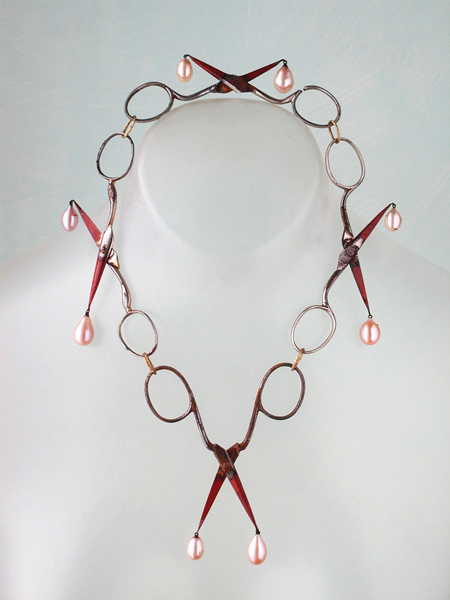
This potential is not secured by the cosmic narrative spun by the artist through the exhibition title’s reference to celestial sculpture, but because the work creates a visceral bodily response; it infiltrates the nerve fibers of its audience. There was an ouch in the mind of every visitor. We cannot know whether or not any of the work would hurt to wear unless we inquire at the shop as to which pieces are still for sale (unusually for a museum exhibition, pieces are available for sale) and try them on. Regardless, Schobinger has arrested his audience with the idea of bodily pain, discomfort, and, in some instances, outright violence. One stone ring (Sunset Ring, 2013) is bisected by a mini circular blade with a bit of lurid paint on either side of its setting that looks like blood splatter, which brings to mind the fingertips inadvertently lost by many a craftsperson at the hands of an unforgiving band saw. In Bubble Boy (2014), a pin is hammered right through the middle of a modest cameo, which takes the blow like a voodoo doll. The violence is not malicious or overtly gory; it is more like a jagged edge, a fragment of fabric caught on a piece of barbed wire that protects private property, a portent of what materials can do particularly when they are fragmented.
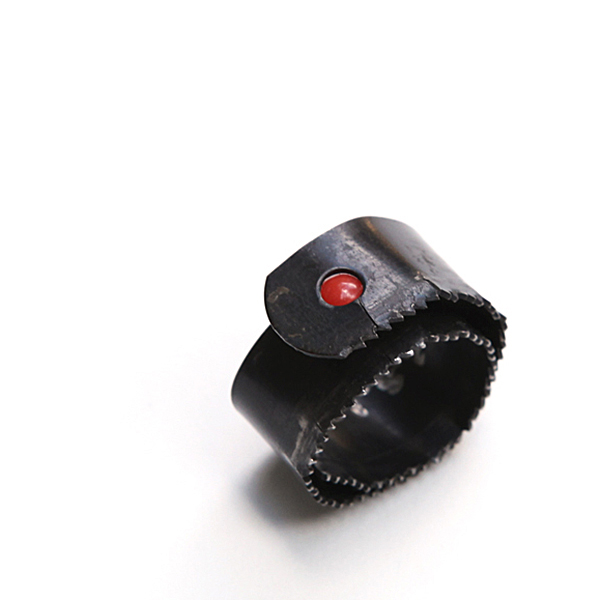
Index image: Bernhard Schobinger, Sunset Ring, 2013, rock crystal, steel, silver, diamond, 8 x 7 x 2.5 cm, photo courtesy of Gallery S O


